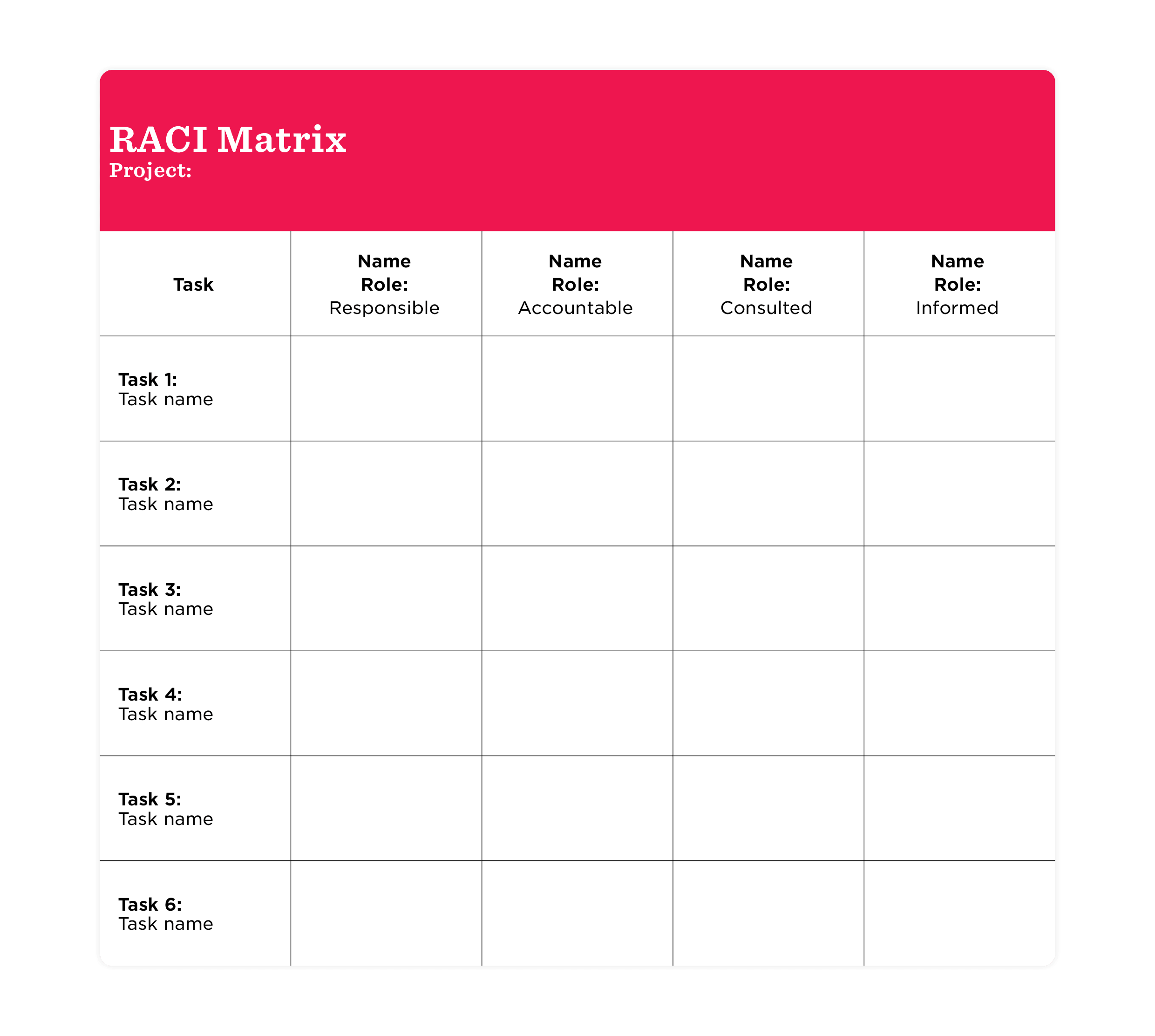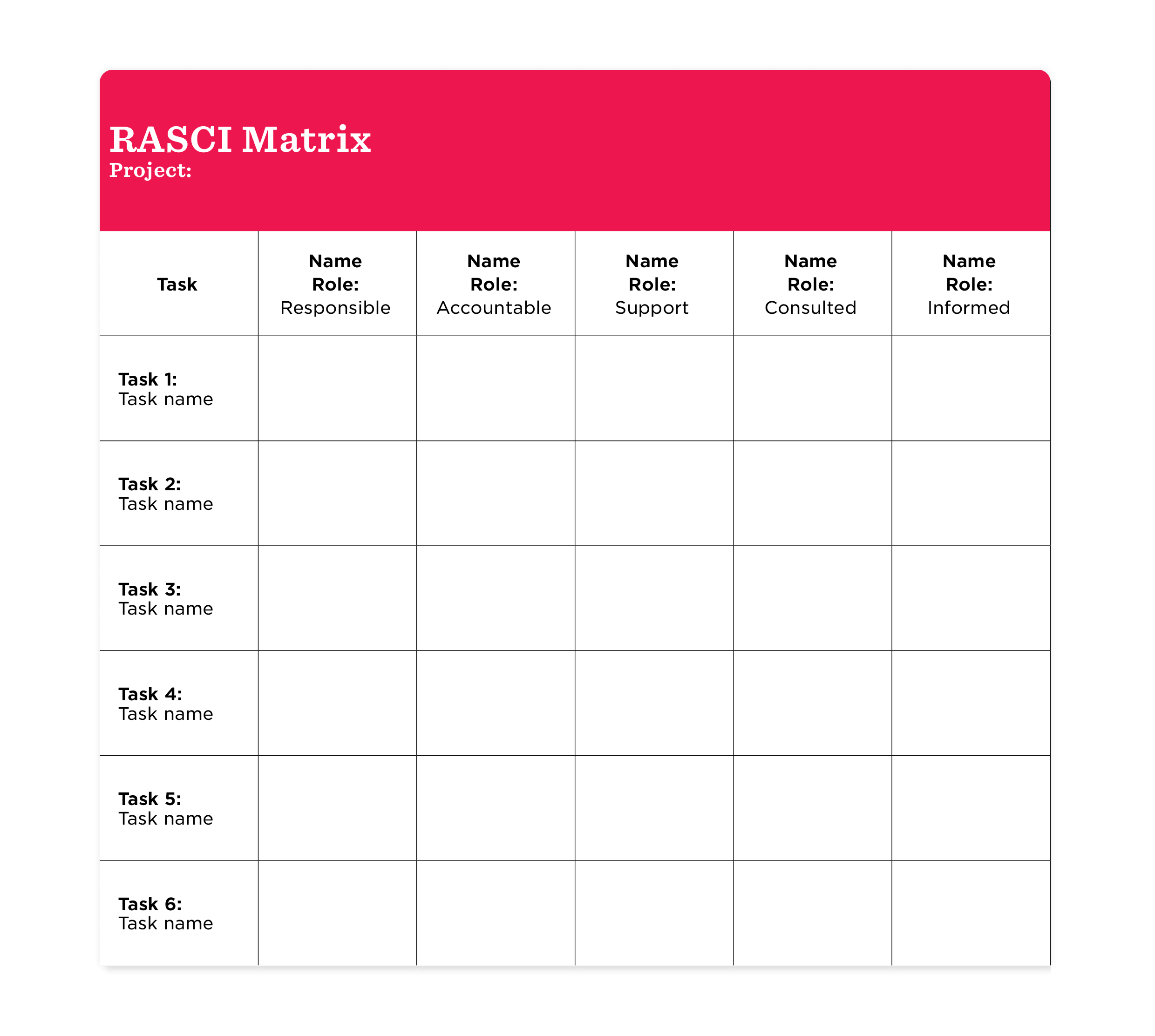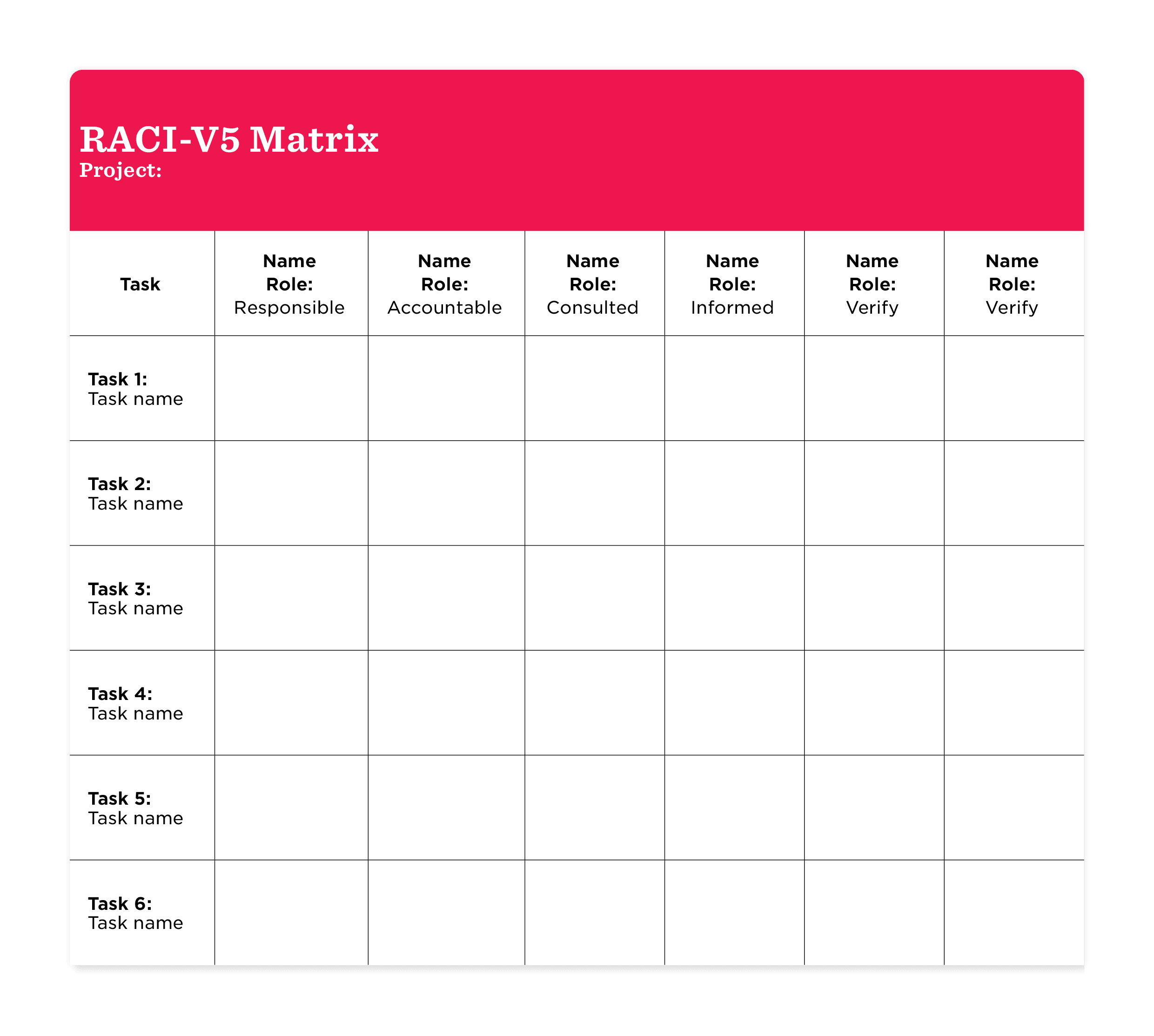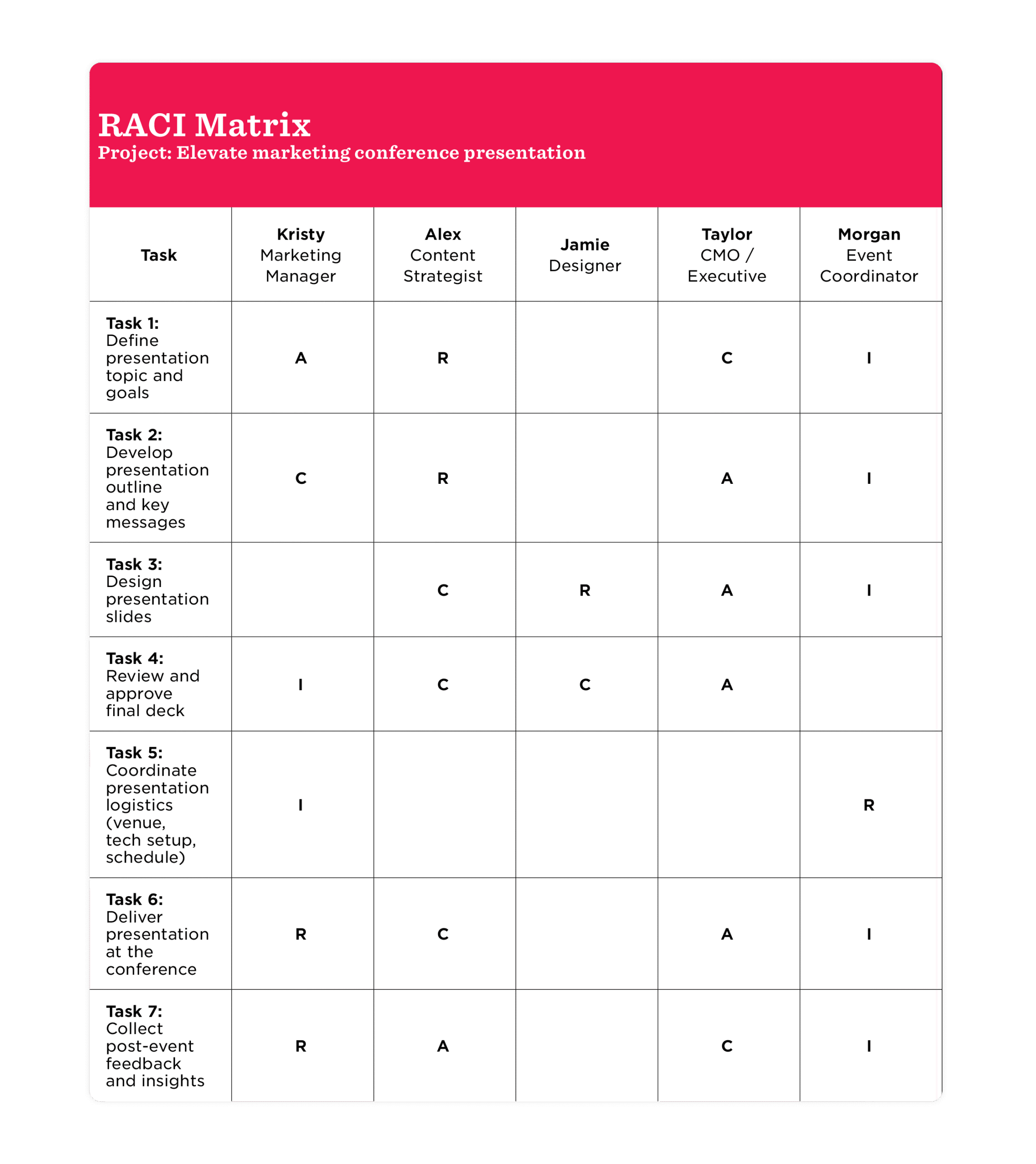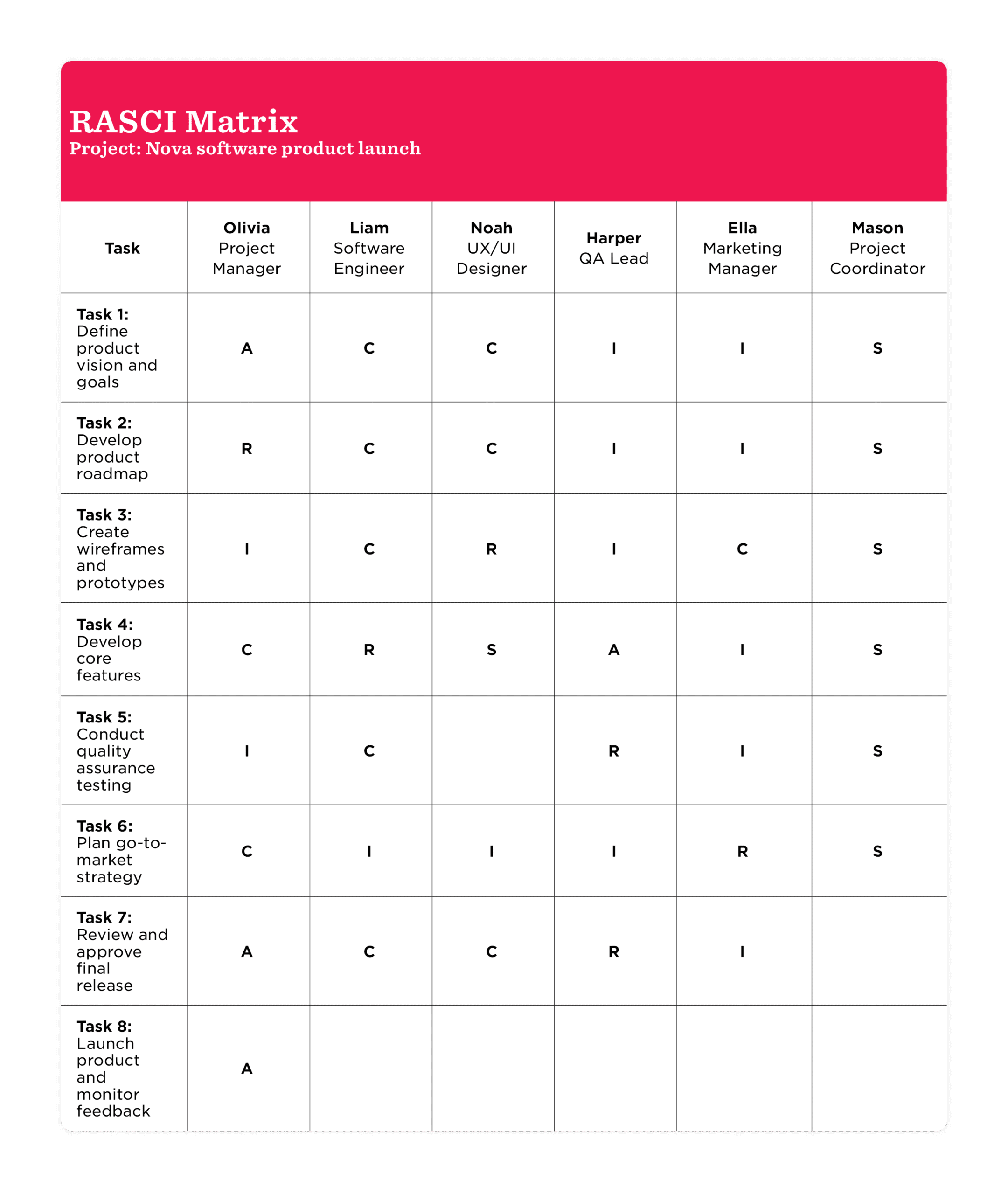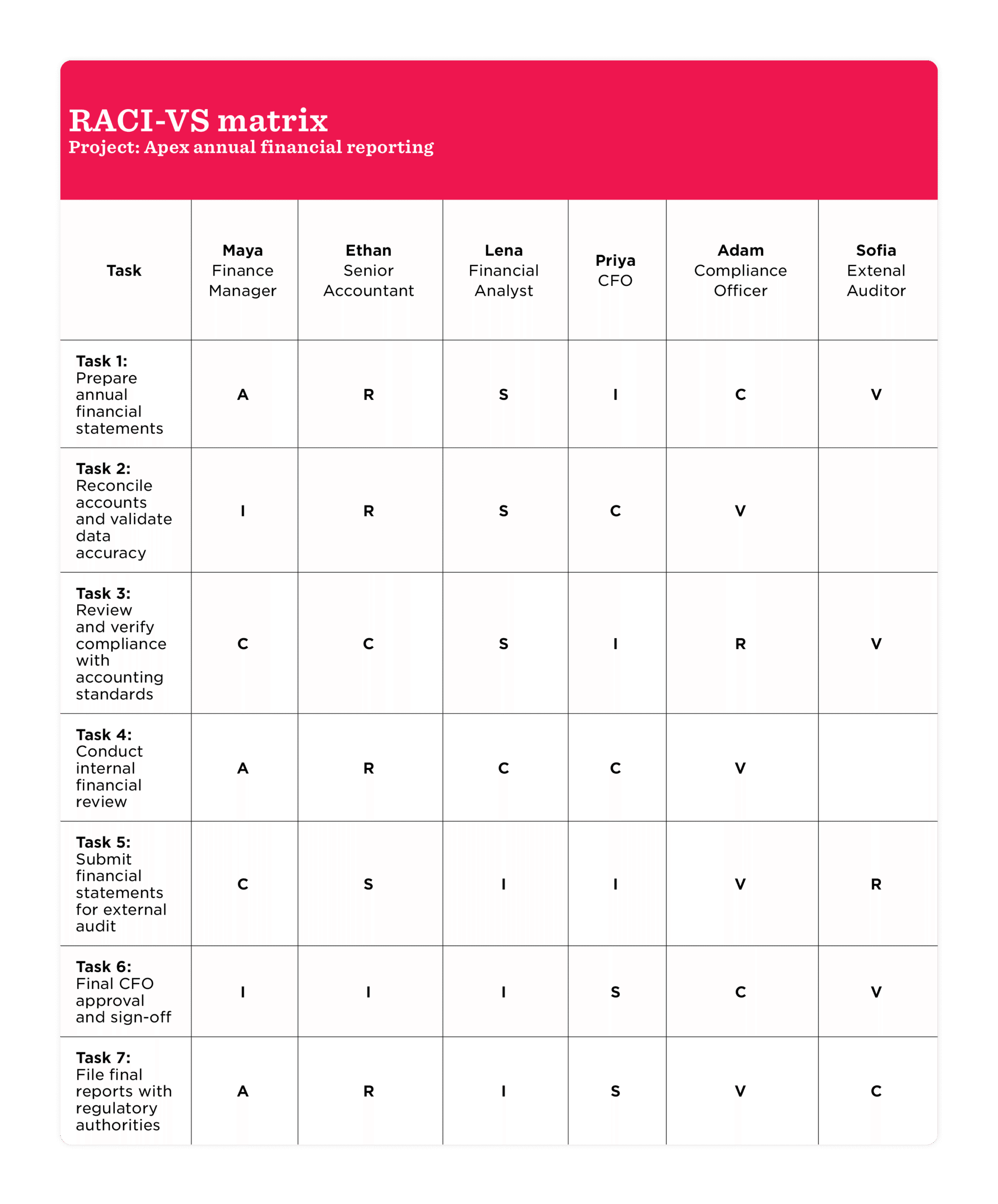Highly engaged teams don’t happen by accident—they happen when every member knows exactly where they fit and how they contribute to the end goal. Well-defined roles create a sense of ownership that fuels engagement—and when employee engagement is high, companies see a 23 percent increase in profitability.
RACI templates are one way to make this level of engagement possible, using clarity to empower confident teamwork. They outline who’s responsible at every stage of a project, so everyone knows where they stand and what’s expected. When roles are clear, people can focus on making an impact rather than chasing updates or navigating confusion.
This guide covers everything you need to know about RACI charts, from basic definitions to real-world implementation strategies. It also features free RACI templates you can use to build structure and clarity into your projects from day one.
<< Improve team collaboration and project outcomes with these free RACI templates >>
What does RACI stand for?
A RACI template is a project management tool used to define and clarify team member roles and responsibilities for specific tasks, milestones, or deliverables. Each letter in the acronym represents a specific type of involvement:
- Responsible: The people who perform the work necessary to complete a task or deliverable
- Accountable: The people who oversee progress, keep teams on track, and own final outcomes
- Consulted: The people who share expertise, offer insights, and help shape decisions
- Informed: The people who stay updated on progress and results without taking a hands-on role
The RACI matrix helps teams stay aligned, use resources effectively, and keep work on track. It’s especially useful for large, cross-functional projects that bring together multiple people and departments.
Types of RACI charts and templates
Choosing the right RACI template comes down to your project’s complexity and how your team works best. Here’s a look at the most common RACI charts, complete with free templates you can download to get started.
Basic RACI
The standard RACI template works for most projects and teams. It features the four core roles in a simple matrix format, with tasks listed vertically and team members and their titles listed horizontally.
RASCI
The RASCI model builds on the traditional RACI template framework by adding a fifth role: Support. This role recognizes the people who actively help the Responsible team members complete tasks, even though they aren’t directly accountable for the final outcome.
Adding a support role is especially helpful in larger HR department structures where senior team members delegate parts of a project while still maintaining overall responsibility.
RACI-VS
The RACI-VS model adds two extra roles for projects that need formal approvals or compliance oversight: Verify and Sign-off. The verify role confirms all work meets the necessary standards and regulations, while sign-off gives final approval before anything goes live.
This version of the template works well for onboarding automation or other workflows where compliance checks and management approvals are key. Industries with strict regulatory requirements typically use the RACI-VS matrix to maintain proper oversight and documentation.
<< Improve your team’s collaboration with these free RACI templates >>
Benefits of using RACI charts
Beyond providing structure and organization, here are some of the key benefits RACI charts bring to people management and project success:
Recommended For Further Reading
Reduced confusion and overlap and enhanced collaboration
Acting as a single source of truth for roles and responsibilities, RACI charts give teams a reliable reference point at every stage of a project. They help prevent mix-ups by clearly defining who owns each task so nothing gets duplicated or overlooked.
The RACI matrix also clarifies each person’s level of involvement, specifying who participates in discussions and who simply needs updates. With clearer boundaries, teams communicate more efficiently while keeping stakeholders engaged with the right level of detail.
Improved accountability
Clear expectations create natural accountability—people know what’s expected, when deadlines matter, and how their efforts contribute to success. When everyone understands their role and how their work fits into the bigger picture, it builds a genuine sense of ownership and pride.
This transparency also boosts HR manager accountability by providing insight into responsibilities and progress. It helps them spot signs that support may be needed, such as missed deadlines or uneven workloads, and step in with timely guidance to keep teams aligned.
Streamlined decision-making
RACI charts accelerate decision-making by clearly identifying who makes the calls and who provides input or stays informed. Consulted team members understand when to offer feedback without feeling the need to approve every detail. With roles established upfront, projects keep moving forward instead of stalling over uncertainty about who has the final say.
Measurable efficiency gains
Together, these RACI template benefits add up to faster project timelines, more purposeful meetings, and better use of team resources. With everyone clear on their roles, status updates can be concise and productive, reducing redundant discussions. This gives leaders space to concentrate on strategy, innovation, and long-term goals.
When to use RACI charts
RACI charts help HR teams stay clear, consistent, and aligned. Here’s when they make the biggest impact:
- At the start of a new project: Clear role definition from day one gives every team member a sense of ownership and direction. Using a RACI template to outline who’s responsible, accountable, consulted, and informed helps HR teams keep projects—like launching a new performance development review system—on track.
- For large or cross-department projects: When HR leads company-wide efforts, such as diversity, equity, inclusion, and belonging (DEI&B) training or policy updating, a RACI matrix provides a structured way to coordinate tasks across departments. It clarifies how each group contributes and reinforces shared understanding of individual and collective responsibilities.
- When approvals or decisions get complicated: Projects that need multiple sign-offs, like employee benefits updates or HR compliance initiatives, benefit from clear accountability and streamlined approvals. A RACI template saves time and reduces bottlenecks by making it clear who has final decision-making authority, who provides input, and who needs to stay informed.
- During restructuring or high turnover: When teams shift or new members onboard, a RACI matrix brings structure and stability. It helps new joiners understand their responsibilities and how their work connects to broader organizational and HR goals.
- For compliance-heavy projects: In regulated industries like healthcare or finance, a RACI template clarifies who verifies compliance, who signs off, and who stays updated, helping HR teams stay audit-ready and confident in their processes.
- When projects overlap or rely on other teams: HR projects often intersect with finance, IT, or operations departments. Using a RACI matrix to map dependencies and communication points keeps collaboration smooth, workloads balanced, and accountability shared across all participating teams.
Real-world RACI examples
From launching a marketing campaign to developing software or managing financial reporting, the following RACI samples show just how flexible and effective the framework can be.
Creating a marketing conference presentation
In this example, a marketing team uses a RACI template to maintain alignment throughout the creation of a conference presentation.
Developing a new software product
This example applies the RASCI framework to a software development project, defining clear roles and responsibilities from planning through launch.
Reporting for annual accounting cycle
Here, the RACI-VS framework maps out each role in an annual accounting cycle to ensure clear accountability, thorough verification, and proper sign-off at every stage.
How to create and use a RACI matrix
With a little upfront planning and stakeholder input, you can create a RACI matrix that makes projects run smoothly from start to finish. Here’s how.
1. List specific project tasks and deliverables
Start by breaking down your project into specific, measurable tasks and deliverables. Focus on the outcome rather than the action. For example, write “Complete market research report” instead of “Research market trends.” This makes responsibilities easier to assign, track, and measure against project goals.
Once you’ve defined your tasks, group them by project stage to create a natural workflow. That way, stakeholders see how their individual responsibilities tie into larger objectives and timelines, making it easier to understand progress at a glance.
Striking the optimal level of detail is key to effective task definitions. Tasks that are too granular can overwhelm your chart, while overly broad ones won’t provide enough clarity. The sweet spot is a meaningful unit of work that typically takes one to five days to complete—big enough to matter, but small enough to manage.
2. Identify all people involved
Next, identify everyone who has a role in the project. “Knowing which individuals you need for the project will facilitate resource planning,” explains Jeannette Collazo, an Illinois-based project management consultant. “So, think carefully about what kind of tasks your project requires and, therefore, which skills are mandatory for the completion of the project.” This ensures you don’t overlook anyone essential to progress or approvals.
List each stakeholder with both their name and role title. If someone changes positions or leaves the team, you’ll still have a clear view of responsibilities and an easier time identifying skill gaps or resource shortages before they slow the project down.
3. Assign RACI roles
Now it’s time to assign RACI roles, starting with who’s responsible for doing the work. Assign tasks based on each team member’s skills, capacity, and authority level. You can have multiple responsible people for a single task as long as they understand their shared role and how to collaborate on their tasks effectively.
Next, decide who’s accountable for each task. While multiple people may share responsibility for completing the work, having a single person accountable for the final outcome means there’s always one owner driving progress, maintaining alignment, and keeping deliverables on track.
Then determine who to consult. Include subject-matter experts or decision influencers whose input or approval is essential before moving a task forward. Choose carefully, since involving too many people can slow progress and create bottlenecks.
Wrap up your RACI template with who to inform. These stakeholders depend on updates to plan their own work or stay aligned with overall progress. Keep communication focused and purposeful—just enough to keep them in the loop without overwhelming anyone with unnecessary details.
4. Review and adjust as necessary
Take a step back and review your completed RACI matrix for balance and practicality. Look for team members who seem overloaded with too many “Responsible” or “Accountable” tasks within the project—that can indicate resource gaps or unrealistic expectations. Adjust assignments so responsibility distribution is fair and the workload feels manageable.
After that, double-check that each deliverable has exactly one “Accountable” person and at least one “Responsible” team member to carry out the work. Confirming ownership now helps you maintain steady progress and makes it easier for teams to stay aligned.
Finish off your review by verifying that “Consulted” and “Informed” assignments make sense given people’s roles and the information they need to be effective. Remove any assignments that don’t add value to project outcomes.
5. Finalize and communicate plans with stakeholders
Before your project kicks off, bring the team together to review the RACI chart. Schedule a short, focused meeting where everyone can ask questions, clarify expectations, and suggest adjustments. This upfront discussion helps catch gaps or overlaps early and builds shared understanding before work starts.
Once the team finalizes the chart, make it easy to access and visible so team members can reference it throughout the project. Better yet, integrate RACI assignments directly into your HR tools to keep workflows organized and transparent.
RACI chart best practices
A RACI chart delivers the most value when it’s clear, consistent, and simple for everyone to use. To create a matrix that provides structure and supports collaboration, keep the following RACI template best practices in mind:
- Get stakeholder buy-in: Collaborate with key players to confirm that responsibilities feel realistic and balanced so everyone carries a fair share of the workload
- Focus on tasks, milestones, and decisions: Use your RACI matrix to outline ownership for major deliverables and key approvals so projects stay on point
- Align tasks with your project plan: Connect each item in your RACI chart directly to your project timeline so responsibilities stay relevant and measurable
- Review RACI definitions regularly: Revisit and update your chart as projects evolve to keep roles accurate and teams aligned
Build clarity and accountability with a RACI template
Whether you’re rolling out a new policy, managing a performance initiative, or leading a cross-functional project, a RACI template gives your team a solid foundation. It adds structure to keep things organized and flexibility to adapt as priorities shift.
RACI charts also support growth. As teams scale or take on new challenges, a clear accountability model keeps responsibilities consistent. New joiners ramp up faster, managers spend less time resolving confusion, and teams stay focused on moving work forward. When people trust each other’s ownership, communication improves, and progress feels more meaningful. And when everyone knows where they add value, it’s easier to stay aligned, motivated, and proud of what you achieve together.
<< Improve team collaboration and project outcomes with these free RACI templates >>

